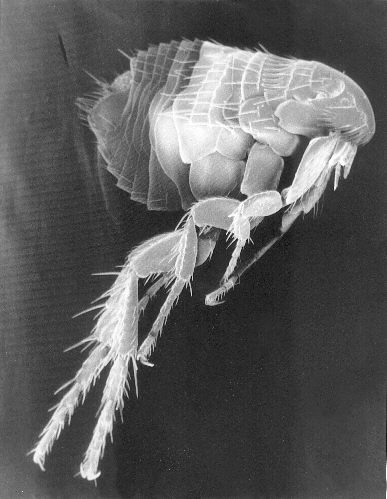- Rat flea
Taxobox
name = Fleas

image_width = 200px
image_caption = SEM of a flea
domain = Eukaryota
regnum =Animal ia
phylum =Arthropod a
classis =Insect a
ordo =Siphonaptera
familia=Pulicidae
genus = "Xenopsylla "
species="X. cheopis"
binomial = "Xenopsylla cheopis"
binomial_authority = (Rothschild, 1903) [Rothschild, N. C. 1903. New species of Siphonaptera from Egypt and the Soudan. Entomol. Mon. Mag. 39: 83–87.] The Oriental rat flea ("Xenopsylla cheopis") is aparasite ofrodents , primarily of the genusRattus , and is primary vector forbubonic plague andmurine typhus . This occurs when the flea has fed on an infected rodent, and then bites a human. The Oriental Rat Flea is most famous for contributing to theBlack Death .Body structure
The rat flea has two eyes, yet it can only see very bright light.Fact|date=October 2007 The oriental rat flea has no genal or pronotal combs. This characteristic can be used to differentiate the oriental rat flea from the
cat flea ,dog flea , and otherfleas A flea's mouth has two functions: one for squirting saliva or partly digested blood into the bite, and one for sucking up blood from the host. This process mechanically transmits
pathogens that may cause diseases the flea might have. Fleas smell exhaled carbon dioxide from humans and animals and jump rapidly to the source to feed on the newly found host. A flea is wingless so it can not fly, but it can jump long distances with the help of small powerful legs. A flea's leg consists of four parts. The part that is closest to the body is the coxa. Next is the femur, tibia and tarsus. A flea can use its legs to jump up to 200 times its own body length. It can also jump about 130 times its own height.The flea's body is only about one tenth of an inch. A flea's body is constructed to make it easier to jump long distances. The flea's body consists of three regions: head, thorax, and abdomen. The head and the thorax have rows of bristles (called combs) and the abdomen consists of eight visible segments.
Life cycle
There are four stages in a flea's life. The first stage is the egg stage. Microscopic white eggs fall easily from the female to the ground or from the animal she lays on. If they are laid on an animal, they soon fall off in the dust or in the animals bedding. If the eggs do fall immediately on the ground, then they fall into crevices on the floor where they will be safe until they hatch one to ten days later (depending on the environment that they live in, it may take longer to hatch). They hatch into a larva that looks very similar to a worm and is about two millimeters long. It only has a small body and a mouth part. (No arms or legs) At this stage, the flea does not drink blood; instead it eats dead skin cells, flea droppings, and other smaller parasites lying around them in the dust. When the larvae is mature it makes a silken cocoon around itself and pupates. This is when the flea spins a white, silken cocoon for itself. The flea stays in this stage from one week to six months changing in a process called metamorphosis. When the flea emerges, it begins the final cycle, called the adult stage. A flea can now suck blood from host and mate with other fleas. A single female flea can mate once and lay eggs every day with up to fifty eggs per day. Fleas like to live in an environment that is warm, where they can live up to a year.
They can stay in the cocoon stage for up to a year if the conditions are not favourable.
History
The Rat Flea was collected in Egypt by N. C. Rothschild along with
Karl Jordan and described in 1903. He named it "cheopis" after the Cheops pyramids. [ [http://www.nhm.ac.uk/research-curation/collections-library/collections-management/collections-navigator/transform.jsp?rec=/ead-recs/nhm/uls-a354904.xml] Manuscript, Drawing and Photograph Collection of Nathaniel Charles Rothschild (1877-1923)]Diseases transmission
This species can act as a vector for plague, "
Yersinia pestis ", "Rickettsia typhi " and also act as a host for tapeworms "Hymenolepis diminuta " and "Hymenolepis nana ". Diseases can be transmitted from one generation of fleas to the next through the eggs. [Farhang-Azad, A., R Traub, and S Baqar 1985. Transovarial transmission of murine typhus rickettsiae in Xenopsylla cheopis fleas. Science 227(4686):543-545 DOI|10.1126/science.3966162]References
External links
* http://animaldiversity.ummz.umich.edu/site/accounts/information/Xenopsylla_cheopis.html
* http://parasitology.informatik.uni-wuerzburg.de/login/n/h/0525.html
Wikimedia Foundation. 2010.
